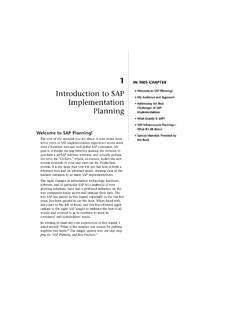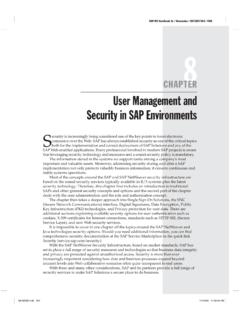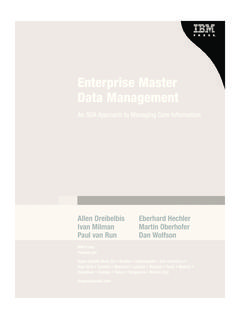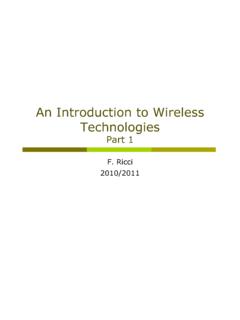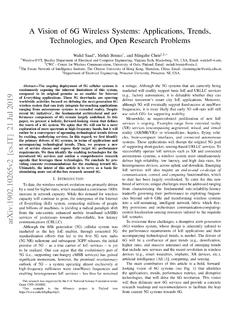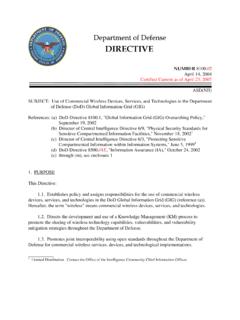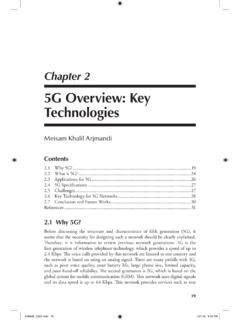Transcription of Introduction to Radio Systems - cdn.ttgtmedia.com
1 Chapter 1. Introduction to Radio Systems Because Radio Systems have fundamental characteristics that distinguish them from their wired equivalents, this chapter provides an Introduction to the various Radio technologies relevant to the IP design engineer. The concepts discussed provide a foundation for fur- ther comparisons of the competing mobile Radio access Systems for supporting mobile broadband services and expanding into IP design for mobile networks. Many excellent texts concentrate on the detail of mobile Radio propagation, and so this chapter will not attempt to cover Radio frequency propagation in detail; rather, it is intended to provide a basic understanding of the various Radio technologies and concepts used in realizing mobile Radio Systems .
2 In particular, this chapter provides an insight into how the characteristics of the Radio network impact the performance of IP applications running over the top of mobile networks characteristics that differentiate wireless net- works from their fixed network equivalents. In an ideal world, Radio Systems would be able to provide ubiquitous coverage with seam- less mobility across different access Systems ; high-capacity, always-on Systems with low latency and jitter; and wireless connectivity to IP hosts with extended battery life, thus ensuring that all IP applications could run seamlessly over the top of any access network.
3 Unfortunately, real-world constraints mean that the Radio engineer faces tough compro- mises when designing a network: balancing coverage against capacity, latency against throughput, and performance against battery life. This chapter introduces the basics of mobile Radio design and addresses how these tradeoffs ultimately impact the perform- ance of IP applications delivered over mobile Radio networks. In Chapter 2, Cellular Access Systems , and Chapter 3, All-IP Access Systems , we use these concepts to dif- ferentiate the competing mobile access Systems defined for supporting mobile broad- band service offerings.
4 2 IP Design for Mobile Networks Spectrum Radio Frequency Spectrum is a key distinguishing factor used to compare alternative mobile Radio Systems . Radio spectrum for communications ranges from approximately 30. Hz (termed Extremely Low Frequency [ELF]) to above 100 GHz (termed Extremely High Frequency [EHF]). Because of its capability to provide very wide area coverage and pene- trate sea water, ELF has been used for global Systems for providing low-rate submarine communications. EHF, on the other hand, can be used for Line-of-Sight (LoS) microwave communications.
5 Table 1-1 shows the complete range of Radio frequency spectrum used in communication Systems and provides some examples of spectrum use. Table 1-1 Radio Frequency Spectrum Band Name Frequency Range Example Communication Use Extremely Low Frequency 3 30 Hz Submarine communications Super Low Frequency 30 300 Hz Submarine communications Ultra Low Frequency 300 3,000 Hz Underground communications Very Low Frequency 3 30 kHz Navigation Low Frequency 30 300 kHz AM broadcasting Medium Frequency 300 3,000 kHz AM broadcasting High Frequency 3 30 MHz Shortwave broadcast; amateur Radio Very High Frequency 30 300 MHz Private mobile Radio .
6 FM and television broadcasting Ultra High Frequency 300 3,000 MHz Television broadcasting, cellular Radio , and wireless LANs Super High Frequency 3 30 GHz Wireless LANs; point-to-point and point- to-multipoint microwave Extremely High Frequency 30 300 GHz Point-to-point microwave Table 1-1 highlights how the characteristics of the different bands of the Radio spectrum vary. In general, the lower the frequency, the better the range (for example, in the extreme case, a single ELF transmitter is able to cover the entire planet), but the bandwidths avail- able are limited (for example, the same ELF Systems typically provided a global system with total system capacity below 50 bps).
7 Conversely, EHF Systems can provide incredi- ble capacity, but they incur significant attenuation by atmospheric effects due, for exam- ple, to extreme humidity, rain, or molecular absorption, and thus are prone to significant losses in non-Line-of-Sight (LoS) deployments. Chapter 1: Introduction to Radio Systems 3. In between these extremes is the sweet spot for the Radio spectrum for conventional mobile Systems , with the Ultra High Frequency (UHF) band ranging from 300 MHz to 3. GHz and providing what many consider to be the best compromise between usable band- widths and propagation characteristics required for wide area coverage.
8 As a consequence, the UHF spectrum is a scarce resource with many competing users. In order to rationalize spectrum usage, the Radio Communications Sector of the International Telecommunications Union (ITU-R) has identified key bands that can prefer- ably be used for International Mobile Telecommunications (IMT) operation. These IMT. bands cover operation for the following: IMT-2000 Systems : Covering legacy 3G technologies , including Wide Band Code Division Multiple Access (WCDMA), cdma2000 1xrtt technologies , and most recently WiMAX. IMT-enhanced Systems : Covering those Systems offering improved mobile broad- band services, including High-Speed Packet Access (HSPA) and EVolution-Data Only (EV-DO) technologies .
9 IMT-advanced Systems : Covering those Systems offering very high-rate mobile broadband operation, including rates in excess of 1 Gbps to low-mobility users. Note In Chapters 2 and 3, we provide more detail describing alternative mobile Radio access Systems ; it will become apparent that none of the current competing Systems , including WiMAX and Long-Term Evolution (LTE), meet the minimum requirements for IMT-advanced Systems . The spectrum for use by the IMT-2000 technologies was first identified by the ITU at the World Administrative Radio Conference (WARC) in 1992 and further augmented at the World Radiocommunication Conferences (WRC) in 2000 and 2007.
10 Even when spec- trum has been identified for use by IMT Systems , it might not be available for sole use of mobile Radio Systems . However, the identification of spectrum by ITU-R, as illustrated in Table 1-2, provides equipment manufacturers with guidance on the range of frequency bands that are likely to be used in deploying IMT services, hopefully leading to economies of scale and consequential decrease in the overall cost of production of spe- cialized IMT equipment. Table 1-2 IMT Spectrum Allocations Frequency Range Regional Rules 450 470 MHz All regions 610 790 MHz Nine countries in Region 3 (Asia and Australasia): Bangladesh, China, Rep.

